Family : Muscicapidae

Text © Dr. Gianfranco Colombo

English translation by Mario Beltramini
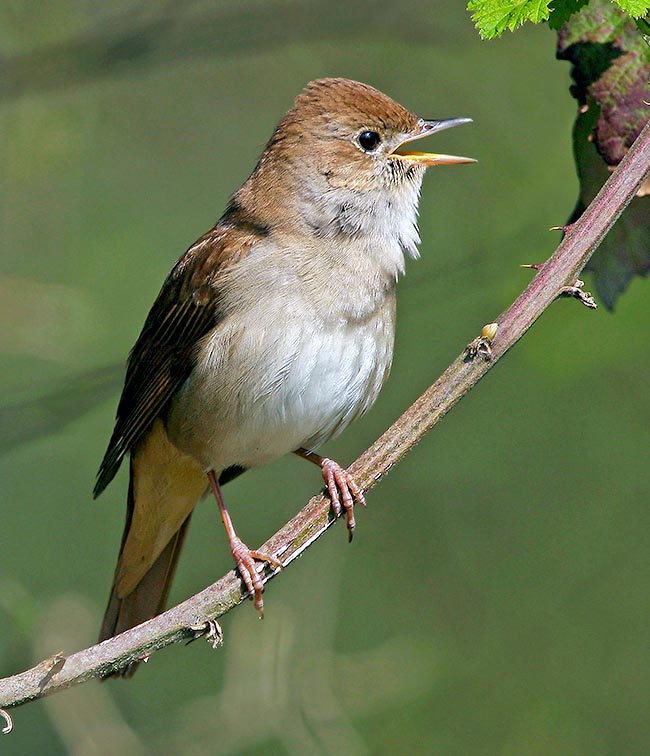
Ready to hide in the woods, even if in city doesn’t fear man, the Nightingale (Luscinia megarhynchos) has a very vast nesting area: continental Europe, part of central Asia and north-western African coasts © Luigi Sebastiani
The legend tells that the Nightingale sang only during the day and in the night rested covered among the bushes of honeysuckle and the vine leaves of the grapevines.
Then, one night, dozing more than usual, a vine clung to its feet, catching it and thus preventing it from flying away when the new day did come.
In this way, in order to maintain its own freedom, the Nightingale learnt to sing during the night, for the duration of the darkness, avoiding carefully to fall asleep.
To tell the truth, there are many legends concerning this bird and every region of the vast distribution area this species occupies, boasts its own tale linked, if you like so, to religious traditions or the legends related with the agriculture or with tales of impossible loves, but in any case always strictly linked to its melodious activity and the odd times in which it carries on the same.
Omitting naturally the night birds that make of the obscurity their own world, few are the day birds singing during the night in such a melodious way as the Nightingale does. Only the Common quail (Coturnix coturnix), the Common cuckoo (Cuculus canorus), the Robin (Erithacus rubecula) and occasionally some warblers (Acrocephalus spp.) and some buntings (Emberiza spp.) imitate it, but never reaching the melodiousness and the emphasis that render famous this bird.
The Nightingale (Luscinia megarhynchos Brehm, 1831) belongs to the order of the Passeriformes and to the family of the Muscicapidae and is one of the most known birds of our Palearctic, even if due to its discretion and its somewwhat modest livery, is practically known only by the ornithologists.
Once assigned to the family of the Thrushes, it is nowadays placed in that of the flycatchers, rightly the Muscicapids
The common name of Nightingale has been used to indicate other species of birds, often not belonging to the same family, that have in their songs or in their behaviour, references leading to this species. In fact, we find the Cetti’s warbler (Cettia cetti), the Rufus-tailed scrub robin (Cercothrichas galactotes), the Japanese Nightingale (Leiothrix lutea) but also the Thrush Nightingale (Luscinia luscinia) that, as we shall see, avers morphologically almost indistinguishable on the field from our Nightingale.
The etymology of the Greek name of the genus Luscinia gets its origin from the homonymous Latin term “Luscinia” = Nightingale and for the species megarhynchos from the Greek “mega” = big and “rhunkhos” = bill, to distinguish it from the congener Thrush Nightingale (Luscinia luscinia).

Upon arrival, late April, reaching the territories of nesting, the males at once stand out for the melodious song used for delimiting their hunting territory and attract females, practically mute, except small calls © Gianfranco Colombo
We must note that Linnaeus initially classified the Thrush Nightingale giving it the name of Motacilla luscinia whilst the common one got a correct distinction only 73 years later, by Brehm.
From a mangling of the term “lusciniolus” = small luscinia, have come later on other verbal tamperings that have led to add an initial r, becoming commonly Rossignol in the Franco-Iberian area.
In other countries, conversely, it is combined to its vulgar name the term “night” rightly because of its particular behavioural characteristic.
In English is Common Nightingale, in German Nachtigall, in French Rossignol philomèle, in Spanish
Ruiseñol comun, in Portuguese Rouxinol comun and finally in Italian, Usignolo.
Very romantic is the Japanese vulgar name of Sayonarakideri, coming from “sayonara” = greeting and “kidori” = affection.
Who did never stop to listen its song during the night?
It is sufficient a bush thick and a little secluded, a row of low trees with a brook flowing at its feet or even a corner of a garden enough vast to create a little of privacy and here suddenly appears, without having been ever seen, this nocturnal singer that cannot go unnoticed, or better, unheeded.
It is not rare to hear it even in the cities, in the public parks or in the old gardens of noble houses, displaying a familiarity that is well going over its shy character.
This cue has given Manning Sherwin the inspiration of the well known song “A nightingale sang in Berkeley Square”, reminding that even in the centre of London these small birds found yore their suitable habitat for cheering up the evenings of the lovers frequenting the small gardens of this tree-lined avenue.
…. The streets of town were paved with stars, it was such a romantic affair and we kissed and said goodnight, a nightingale sang in Berkeley Square ……
No less than many European poets have recalled it in their poems, not only for the romance and for the strong pathos of its singing but also as messenger of the beginning or of the end of the night.
Shakespeare makes Juliet say Romeo at the daybreak of the night of love with Romeo: … “It is not yet near day. It was the nightingale, and not the lark that pierc’d the fearful hollow of thine ear; nighty she sings on yon pomegranate tree: Believe me, love, it was the nightingale ….”
Conversely, Carducci, in his poem “In front of San Guido”, announces the arrival of the night recalling: “And as this sunset is full of flights, how cheerful is the sparrows’ chirping? At night the nightingales will sing: remain, and the guilty ghosts, oh, do not follow….”
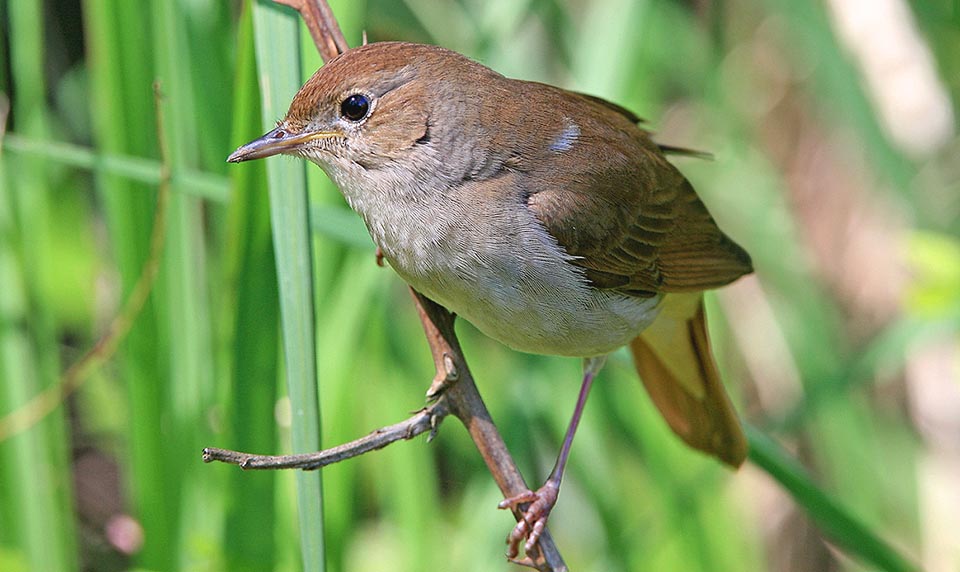
The main food of this small bird consists in insects, their chrysalises and their grubs, and all invertebrates it finds among grass and on branches. Before leaving again, in August, changes however type of food passing partially to berries ans wild fruits to reach the quantity of fat needed to face the long trip to central Africa © Luigi Sebastiani
Directors, musicians, writers then have completed the literary context about this beloved bird. Vivaldi, Haendel, Beethoven, Mendelssohn, Liszt, Respighi, in centuries very distant from each other, have been able to repeat its singing in their unforgettable musics.
Zoogeography
The nidification area of the Nightingale is extremely vast and covers continental Europe completely, part of central Asia and the north-western coasts of Africa.
It is not present north of the coasts of the Baltic Sea, in Ireland and in Scotland, in all Scandinavian countries and eastwards, is absent in Poland and in Ukraine, in central-northern Russia and in all the area sited at the same latitude up to Mongolia, the easternmost part of its range, inhabited by sparse and small populations. The southern limit of its area, sees the presence of some populations in the Arabian Peninsula, in Iran, in Afghanistan and north of the Himalayan Chain up to reach again Mongolia.

Here it can stand bold in sight to control well its small territory, whist during the African wintering it is very shy, almost silent, if it were not for small warning signals it emits for all approaching dangers © Gianfranco Colombo
The Nightingale is a long range migrant and all populations spend the winter in Africa, in a belt following in parallel the southern limit of the Sahara Desert.
From Senegal, it reaches seamlessly the Horn of Africa, this last area collects the eastern Europe populations as well as the Asian ones.
The migration northwards sees the first specimens reaching the territories of nesting around the end of April, whilst the autumn migratory phase begins already from the month of August to the end about ten of weeks later.
Ecology and Habitat
The habitat frequented by the Nightingale during the nidification, strongly differs from the one where it winters.
Whilst in the last instance, the life of this small bird is linked to a real struggle for survival, as it has to compete with the autochtonous species it finds in the wintering locations, during the nidification it finds easy to conquer the ideal habitat where to grow and perpetuate the species.
The Nightingales are present in woody habitats, in dense thickets, in brambles and in riparian shrublands, along waterways even if of reduced dimensions, in the thick Mediterranean shrubland and any other place that can guarantee an arboreal coverage, even if not tall and that ensures the presence of a clean and humid undergrowth, rich of humus, where it is possible to go scratching.
Hazel groves, copse groves, of robinias and alders, low planetrees with the fronds facing waterways, are the ideal site for this small bird. In this environment it finds the suitable place for nourishing, nesting, and hiding to the sight to the one who would like to observe its innate and very evident singing events.
Although being strongly reserved, the Nightingale does not fear the human being and in fact invariably chooses a sufficiently high position from where to easily observe all around, but often disdaining to move even if persons are approaching.
So, here is explained how at times it enters the cities, facing the noises and the strains of the urban life. Indeed, in this sense, some scholars have verified how the city Nightingales vocalize with a more marked tonality than the country ones, rightly because they try to overwhelm with their song the noises of the cities.
The Nightingale knows to be practically invisible when hidden and takes perfectly advantage from its inborn gift of mimicry.
Unlike the Thrush nightingale, the common one prefers more sunny and temperate climates even if it avoids the too arid and warm areas.
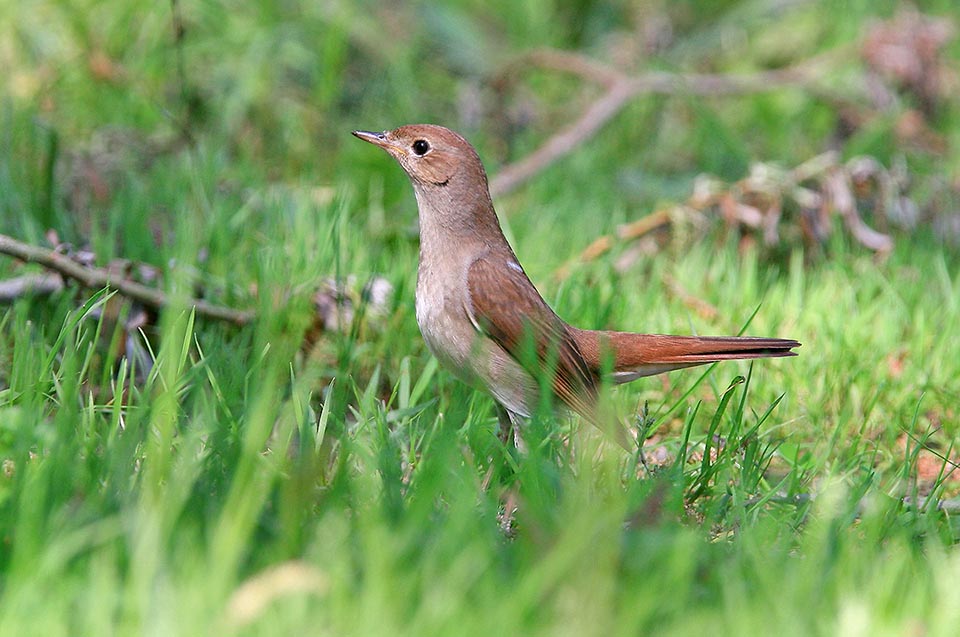
Actually, in tropics the habitat is hostile for a small bird born for thickets and brambles, the waterways and a humid and clear underwood rich of humus, where it can scratch © Luigi Sebastiani
The abandonment of the rural areas has increased the formation of environments suitable for the presence of this bird even if the structural change of the type of agriculture, done in vast areas of our territory and primarily addressed to the monocolture, has conversely cancelled completely in some regions its traditional habitat.
In the wintering areas the environment is rather various, being usually dry and shrubby as usually is the sahel even if the bigger density is found in riparian areas along rivers ans waterways and more or less dense thickets. There, the Nightingale is even more bashful of what usually is, maybe unable to be at ease in habitat completely different from the one it has just left and where the hiding means more than anything else, the survival.
In Africa, it does not create its own territory to defend, does not sing, keeps almost silent if it were not for small warning signals it emits for all approaching dangers. Wintering in foreign lands is a difficult period for all migrants who, besides being obliged to adapt to an environment not belonging to them, see a very strong feeding competition with the local populations.
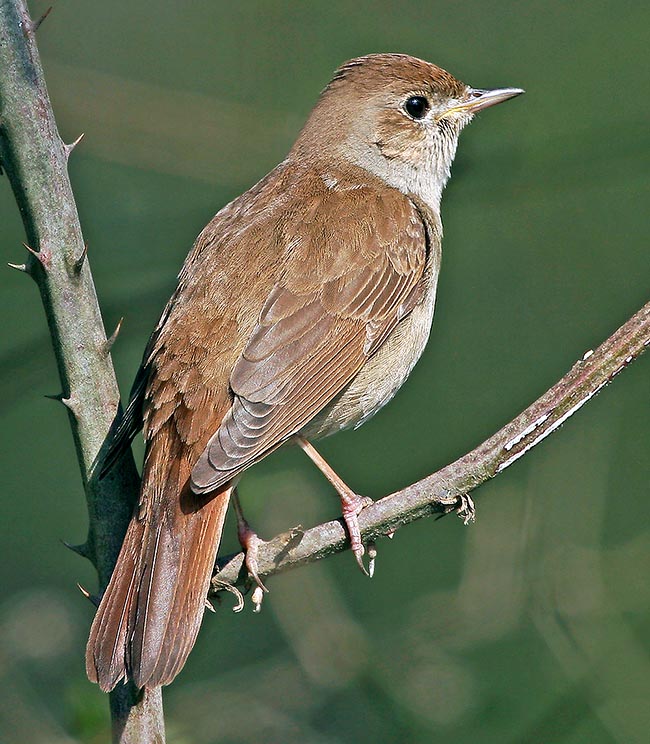
The Nightingale has a very modest livery: chestnut brown in body’s upper part and pale cream white on all chest, up to the tail. Rarely touches 17 cm of length, weighing only 23 g and an about 24 cm wingspan © Luigi Sebastiani
Morphophysiology
So much beautiful is its song, so insignificant is its livery.
You would think that with the gift of the nice singing the nature had thought of having already given more than due to this bird, so that it would not deserve anything else.
Nothing strange! The Peacock (Pavo cristatus) has had its fantastic tail and a song which stands among the most unpleasant in nature and the Nightingale got the same gift, but on the contrary!
On the other hand, if this small bird had gotten a phantasmagoric livery, it would have been a frequent victim of the predators seen its evident and persistent way for announcing its presence, presently hidden by a natural mimicry.
The Nightingale has a very modest livery, monotonous in colours.
It is totally chestnut brown coloured in the upper part of the body and of dull white colour on all the chest, up to under the tail.
Only peculiarity is rightly the tail that displays a paler hazelnut colour more marked particularly when this small bird darts flying, at the ground level, among the bushes.
It has a total length rarely touching the 17 cm, a weight of 23 g and a wingspan of about 24 cm.
Consequently it is clear the reason of its mimicry when it is immersed in the thick shady branches of a bush of brambles. A small bird, camouflaged, hidden in the shade and almost always motionless.
Unlike the sylviids and the warblers, birds frequenting the same environments, the Nightingale does not have the continuous liveliness of movements typical to these families, preferring to keep still and hidden on a twig, during the song as well as when waiting for a prey.
There is no sexual dimorphism and the immatures themselves are recognizable only initially by the tail, shorter and blunter than that of the adults. The maturity is reached during the second year of life.
Three subspecies have been classified, strictly related with the specific areas occupied, Luscinia megarhynchos megarhynchos of Europe, Middle East and North Africa, Luscinia megarhynchos africana of Anatolia, Caucasian region, Iraq and Iran, and Luscinia megarhynchos golzii, of central Asia up to Mongolia.

The nest is at few centimetres from the soil: a deep cup hiding almost completely the hatching female. Usually contains 5 eggs, also very mimetic © Museo Civico di Lentate sul Seveso
Reproductive Biology
The Nightingale begins to sing as soon as it has reached the site chosen for nesting. Males do arrive few days before the females, in order to occupy an area and to begin to signal the migrating females their presence and the successful conquest of a territory.
The Nightingale singing evidences that the migration occurs during the night even if the song, moved by the seasonal excitement, goes on and continues increasingly also during the day in particular in the weeks following the arrival, when the male, besides signalling its ownership on the territory, comforts the female busy in hatching.
The nest is built by the female, under the male supervision, placed at few centimetres from the ground, or even there, between the twigs of a pollarded stump of an alder or of other shrubs. Rarely it’s found few decimetres far far from the soil, hanging among the low brambles but always well hidden to the sight and perfectly camouflaged wih the surrounding environment.

Incubation lasts less than 2 weeks, and the young, assiduously fed by the parents, leave the nest after 12 days. For about 2 weeks more they will be followed, the time to learn the hunting art © Museo Civico di Lentate sul Seveso
The nest is built with juxtapposed dry leaves, so that it looks like a disorderly mass of rotting material but, on the contrary, reveals a deep cup perfectly built, lined with finer and more delicate dry material that renders the nest extremely comfortable for the deposition of the eggs.
The female when squatted on the nest, practically disappears from the sight in the depth of the nest, leaving exposed only the tip of the tail.
Also the usual 5 eggs are very mimetic, having a compact grey-green colour that renders them invisible thanks to the depth of the cup and the very shady place where the nest is located.
The hatching, done by the female only, lasts less than two weeks and after 12 days more the juveniles leave the nest even if assiduously followed by the parents for at least a couple of weeks more.
In suitable climate conditions, the Nightingale may do two hatchings per year. The couple is monogamous for only one reproductive season.
The main food of this small bird consists in insects, their chrysalises and their grubs and, generally, of all other invertebrates. During the time preceding the migrationn the Nightingale modifies the type of feeding partially changing to berries ans wild fruits, in order to acquire that quantity of fat necessary for facing the long voyage towards central Africa.
Returning to its vocal behaviour, the repertoire of the Nightingale has no comparison with other birds due to the melodiousness of the tones, for the huge number of trills and for the strength of the singing.
It has been calculated that the adult males, with some years of singing experience, can exceed the 200 of types during their song. Whistles, trills, modulations and glissandoes, are regular part of their singing repertoires. This vocal capacity is learnt by the young from the first days of their take off, listening and imitating their old teachers.
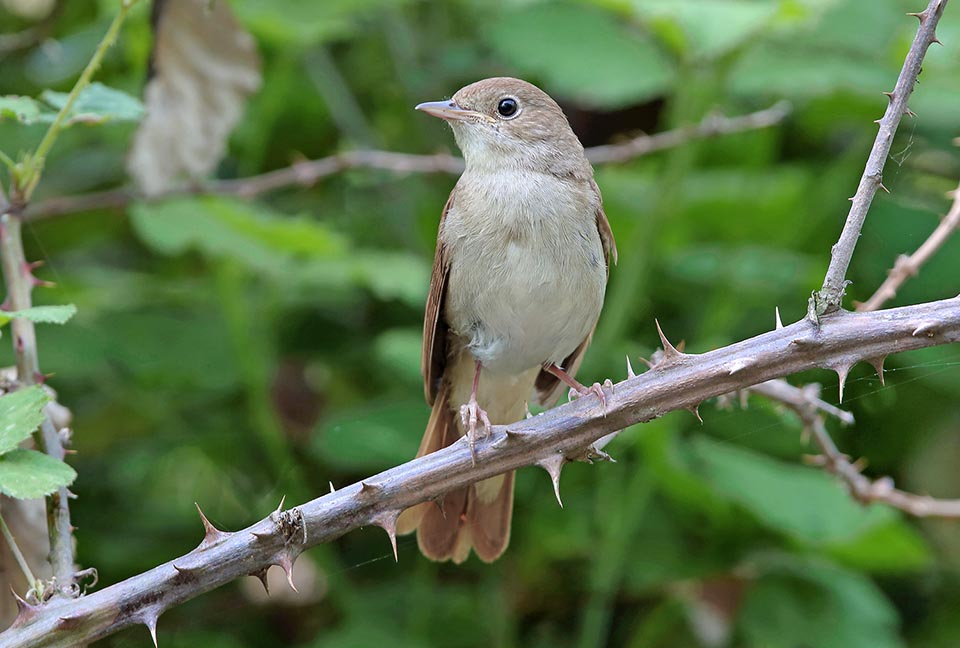
The populations of Luscinia megarhynchos are stable and considered also the vast area today is not a species under risk © Bruno Dentesani
Only in this way they will be able, on the following year, to conquer a territory and attract a female in migration: the greater is the singing capacity of the subject, more numerous will be the chances of conquering a partner. However, not all will succeed in learning and often several seasons will be needed before getting the full success. In this regard, but on the other hand this occurs frequently among the singing birds that occupy vast distribution areas, it has been noted among the Nightingales the use of local dialects distinguishing them from the various strains of origin.
Finally, this Nightingale will be, yes, an invisible bird, shy and bashful, lover of loneliness and quiet but it still remains on of the birds more loved and known by the populations sharing the territory. Its song does not need translations: it is a language without boundaries, an international message of melancholy, a nice timeless “leitmotiv” that has accompanied through the ages the passionate and romantic summer night of our countries.
As said Giambattista Marino, Italian poet of the Kingdom of Naples, just five centuries ago…. “in a thousand of shapes its song distinguishes and transforms one language in one thousand of languages!
→ To appreciate the biodiversity within PASSERIFORMES please click here.
